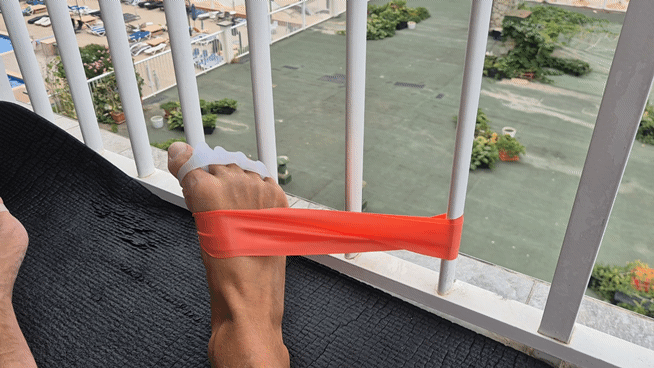Earlier this month I visited a Physiotherapist and a Podiatrist to give me a long overdue professional opinions on my feet and ankles.
Due to the five week wait for an appointment with the Podiatrist, the Physio visit came first and I met with an English lady based just a few minutes drive from home. The visit involved analysis of posture, muscle use, and possibly alignment related to pain or movement dysfunction.
The focus was my feet and ankles, although the issues here have meant problems further up the chain with the knees and hips in particular. Despite having a reasonable arch, my feet fall inwards (left more than right), and the mid foot barely touches the floor when I stand.
The physio asked me to walk up and down the room a few times, had me doing squats, and also gave my Plantar muscles on each foot a massage. I didn't notice this muscle is perhaps weak or was sore prior to the thumb-press, and the Physio mentioned I could do with rolling a ball underneath my foot - which I have since been doing most days.
For both appointments I took 4 pairs of footwear, my go-to insoles, and an ankle strap. There are days where I will wear all four items of footwear, and both the Physio and Podiatrist noted it that it was 'good' for my feet to be tested this way, and that included a lot of barefoot time indoors.
I walk differently in each footwear and when barefoot. If support is good, I'll strike more with my heel, and If there is no support, I'll probably be walking on the front of my foot and even my toes. The less support I have the more conscious I need to be when walking - each step barefoot I'll engage my foot ready for impact, and keep the foot ready to push away with the front foot and toes. This is a ball-ache, but it stops my foot from collapsing and my Achillies from getting sore.
What is your long term goal?
The Physio asked. See - my feet are reasonably strong, and my balance is decent due to a lot of practice on the boards both sea and dry land. I told her I wanted to be able to walk and at least jog pain free for the rest of my life. Apparently this should be doable as long as I keep exercising both core and balance muscles to compensate for lax tendons.
It was good to chat to someone who could see the issues I have, sympathise, and also commend me on the work I've been doing to keep everything working. Onto the Podiatrist...
I'm glad I added this appointment to my calendar as I would have missed it, instead of turning up after a few bottles of Beer :) Well, at least I could stand on pad which scanned my feet and produced the following:

This static analysis done standing measures Surface area contact (cm²), Pressure distribution (%), and Force distribution (weight-bearing).
Whilst my feet look to fall into the 'Cavus' (High arch) category, the midfoot area shows more load than ideal, especially on the left — consistent with flattened arches (pronation). Also, my heels are bearing less load than average, especially on the right suggesting that weight is not being well distributed during standing — again possibly due to arch collapse.
However, the pressure map contradicts this because:
-
There's no real pressure along the lateral (outside) edge of either foot.
-
Most pressure is central to medial — forefoot and midfoot, especially under the ball of the foot and big toe.
-
The heel pressure is low and not laterally biased, which you'd usually see in cavus feet.
So I have the (low) surface area often seen with Cavus feet, and more pressure on heel and ball of foot. However, what I don't have is a lateral load bias - more weight on the outside of the foot.
Summary - Pronated feet not benefiting from the shock absorption a neutral or Cavus foot might offer, and instead the load issues typical of flat feet — especially through the midfoot and forefoot. Apparently this is known as a "Collapsed cavus" — a foot that looks arched, but functions flat due to muscle weakness, poor control, or fatigue.
The physio told me that my foot muscles are 'probably as strong as they can get' (its the tendons that are genetically weak), but after chatting to my virtual physio, I think there's more I can do!
Standing on my toes and performing calf raises whenever I remember has helped increase my foot strength, but I've not been training in isolation what is perhaps more important for me.

This is a banded eversion - a targeted isolation exercise which activates the lateral stabilizers of the lower leg and foot. I'm doing these and the inversions every other day at present. I'll let you know how my stability fares...
The Podiatrist took moulds of my feet and I'm currently waiting for a pair of 150 euro insoles. These will likely go in my running trainers, but I'll see how they suit the barefoot shoes I have. I don't want my feet to become too reliant on any insoles but these will be the best set I've owned - custom for me and not Amazon essentials :)
I hope everyone is looking after their feet!
Ash